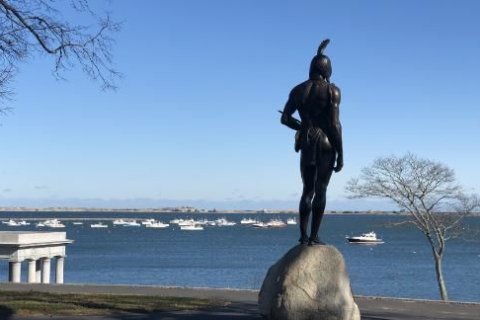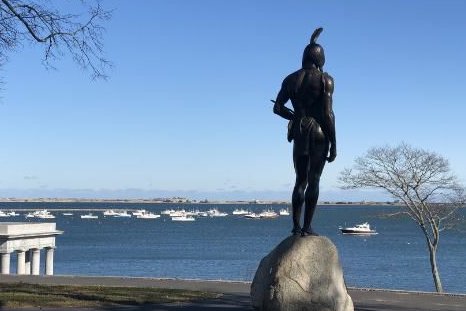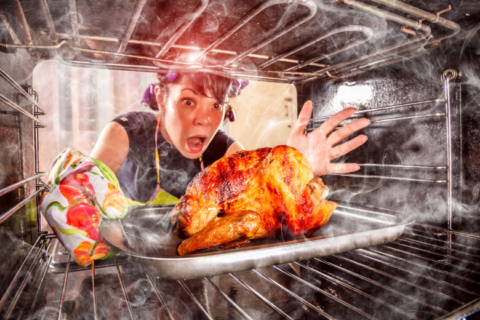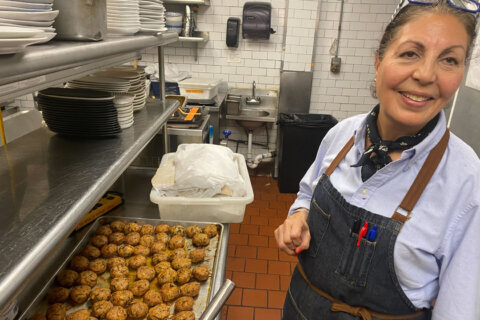
While cleaning out her first grade son’s backpack last week, Elyse Gilbert found something that surprised her. Mixed in with the regular detritus of the school day, the crumpled sweatshirts and food wrappers, was a blatantly inappropriate Thanksgiving-themed worksheet.
On the top of the page: a smiling cartoon Native American with his arm around a giant piece of corn. Below, a word scramble featuring Thanksgiving-themed vocabulary words. Her son had successfully reassembled “inIdan” to “Indian.”
“I literally gasped. I had assumed they had an updated curriculum about Thanksgiving,” she said, explaining that she thought educators had moved beyond the fairy tale version of the holiday she learned three decades ago. You know, the one about togetherness and bounty that conveniently leaves out the part of the story in which Native Americans were systematically murdered and oppressed and replaces it with a second helping of pie.
The incident left Gilbert, like many non-indigenous parents today, questioning how to celebrate Thanksgiving with her children. Indigenous families have been wrestling with, and resisting, the myth of Thanksgiving for as long as it has been around. Today, some Native Americans celebrate the holiday, often connecting it to their culture’s traditions of Thanksgiving, while others consider it a day of mourning.
As our country reckons with the persistent racism and cultural insensitivity that has, for so, so, long, been hiding in plain sight, yesterday’s model of Thanksgiving no longer cuts it. It’s time to figure out what’s next.
“We are Americans, we can make the holiday into anything we want it to be. We can choose to celebrate each other,” said Rep. Deb Haaland of New Mexico. In 2018, she became one of the first Native American women elected to Congress.
Please don’t pass the narrative along
The first step is to take a red pen to the insensitive myths and practices surrounding Thanksgiving, particularly as it is taught to young children. Curricula for the holiday vary wildly across the country, and some children might simply be learning about gratitude, some about the oppression of indigenous people, and, still, some might be encouraged to dress up like Pilgrims and Indians to recreate the romanticized first Thanksgiving that never was.
“We’ve advanced this fictional narrative and used Thanksgiving to create a national story that is not true,” said Maureen Costello, director of Teaching Tolerance, a project of the Southern Poverty Law Center, which has a great resource sheet on Thanksgiving.
Holidays evolve over time. Christmas didn’t always have Santa Claus. Easter didn’t always have a bunny. Likewise, Thanksgiving wasn’t always about joyful communion between English colonizers and Native Americans — a joyful communion that is about as steeped in facts as a bearded man delivering presents via a chimney. “It is time to drop this historical fiction.”
The practice of dressing up like Native Americans, or engaging with any media that presents indigenous people as cartoonish historical relics, however well-intentioned, is also a bad idea. When children learn about Native Americans this way, it has a number of negative consequences, Costello explains.
For one, the cutesy, Disneyfied version of the holiday subtly teaches children that Native Americans are a thing of the past. They become more once-upon-a-time, than the neighbors and fellow citizens they are and who, in many cases, are still fighting for equal rights and fair treatment. It also deceptively smooths out a history that should be taught with all its rough edges.
“In a perfect world, I would return Thanksgiving to a harvest festival,” Costello said. “But in the real world, we have this [inaccurate] story out there, so parents and teachers need to tell the truth.” She said that if children have had no exposure to the Thanksgiving myth, then parents might consider framing the holiday as a time of gratitude, saving the history lesson for another time.
But considering how ubiquitous the myth still is, odds are that most adults will have some explaining to do.
New ways to seek meaning
Gratitude is what Haaland focuses on during Thanksgiving at her home. “We don’t celebrate it because we think the first colonizers had a great dinner with Indians. We do it because it is a time to give thanks to our family and think about how we all have something to be grateful for. Personally, I think a lot about my grandparents and what they did to protect our culture and traditions for us.”
This is on Haaland’s mind a lot these days as she sees a resurgence of activism surrounding sacred sites, and a rise of elected officials from of Indigenous descent. All this makes it easier for all of us to see how “Native American history is American history,” she said. Today, anyone with an Internet connection and a bit of curiosity can get a better understanding of the past and how its patterns and themes continue to play out today.
Tai Simpson, a member of Nimiipuu nation (Nez Perce Tribe of Idaho) and community organizer for Indigenous Idaho Alliance, does not personally celebrate Thanksgiving, but is not opposed to others observing the holiday. The key, as she sees it, is making it relevant.
“You can celebrate with your families, but understand that lots of sacrifices were made for this country, and the descendants of those who made these sacrifices are still around,” she said.
When Simpson teaches the holiday in schools, she emphasizes its current manifestations. What is the reality for Native Americans today? How did we get there? “Young people can handle it. They can navigate hard questions, and learn history in a way that is thoroughly honest.”
For small children, this might begin with a recognition that British colonists were not good sharers. As kids mature, so should the content. Also, such discussions could include learning more about the history and culture of local Native American tribe or tribes, if there is one or more nearby.
As for families with indigenous roots, she suggests they consider reconnecting with their culture on Thanksgiving. Some tribes have pow-wows on the holiday which “helps with healing and community building.” Others take the days off to teach children their native languages, revisit their creation stories, and overall connect with their culture. “It’s a chance to look at what our people used to do and think, ‘I can do this now.'”
Reckoning with a checkered past might be challenging, but it’s also essential for our current demographic reality, said Anton Treuer, professor of Ojibwe at Bemidji State University and author of “Everything You Wanted to Know About Indians But Were Afraid to Ask.”
“White Americans have developed ways of interacting with Thanksgiving that revolves around white comfort, rather than the needs of kids of all races,” he said. “But now, with the majority of K-12 students being students of color, figuring out how to get along with people who are not the same as you, and understand people who are not the same as you, is vital.”
Understanding another culture’s history and current status is a big part of this, as is appreciating the wisdom and grace in their cultures. Treuer suggests starting with honoring the fact that many of the foods we eat on Thanksgiving, including turkey, cranberries and potatoes, came from Native American cultures.
Also, worthy of every single person’s attention is the tradition of respect for the natural world and the ways in which it provides for us, found in Native American cultures. This is a lesson we should have learned a long time ago, before systematically destroying our planet.
Lastly, we can think of our responsibility to one another, another important value among Native American communities, and how we can make the things we are grateful for, be it food or company, available to those who don’t have it.
Treuer says at his family’s Thanksgiving, they mix all these feelings and ideas, and more.
“We get together. We talk about history. We are grateful. We are mindful. We remember our ancestors,” he explained. “It doesn’t mean everything is always solemn. You can do all those in the same space.”








